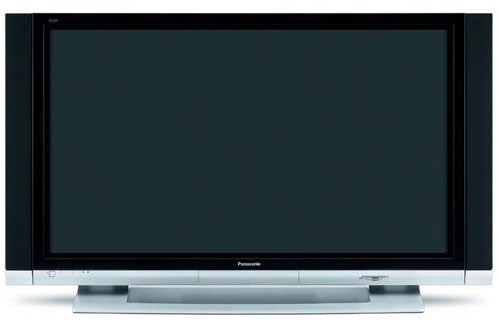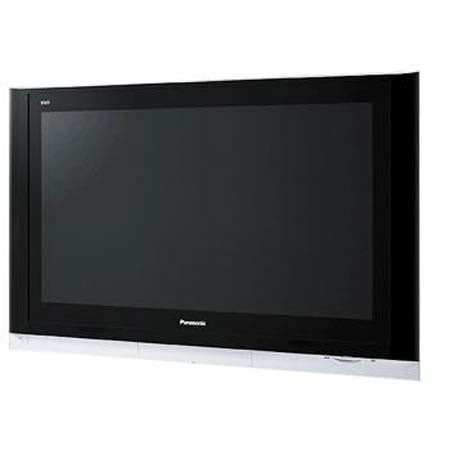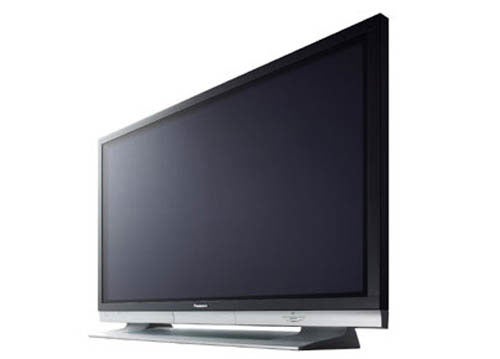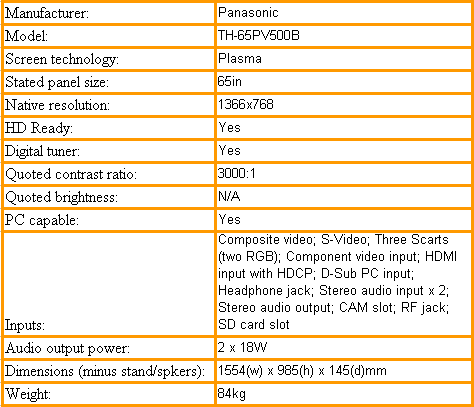Panasonic TH-65PV500B 65in plasma TV Review
Panasonic TH-65PV500B 65in plasma TV
If you have a living room the size of an aircraft hanger, Panasonic has just the TV for you.

Verdict
Key Specifications
- Review Price: £7000.00
OK, we admit it: some days our job really isn’t too bad. For instance, until about five minutes ago we were playing Oblivion on our Xbox 360 in high definition on a 65in plasma TV and calling it work. Sweet.
The cause of this ‘hard life’ scenario is Panasonic’s TH-65PV500B: one of the very few truly giant flat TVs that’s been designed from first to last with your ‘Average Joe’ home user in mind. Well, Average Joes with seven grand to spare and a living room the size of the local village hall, that is…
The 65PV500B’s domesticity starts with its looks. It’s actually part of Panasonic’s popular and acclaimed Viera range, and in keeping with many other sets in this range it looks resplendent in its glossy black fascia and silvery trim. It’s worth saying, too, that considering the monstrous amounts of heavy screen glass the TV chassis has to support the screen frame is actually reasonably slinky, making sure the TV doesn’t take up any more of your precious wall space than it really has to. The speakers are detachable, too, so that you can position them away from the screen, or else ditch them entirely in favour of your own audio system.

Connectivity is for the most part impressive. You get the customary HDMI and component options for HD sources, a PC jack for king-sized World of Warcraft sessions, three SCARTs (two of which can take RGB-quality signals), and an S-Video socket. Plus there’s a nifty slot for inserting an SD memory card for playing back or (unusually) recording MPEG4 movies or digital JPEG stills.
The only slight miffer on the connections front is the presence of just one HDMI input. After all, it’s hardly as if Panasonic didn’t have room to fit an extra one on if it had really wanted to!
As you’d expect of such an uncompromisingly large TV, the 65PV500B is fully HD Ready, with a native resolution of 1,366 x 768 and compatibility with the required 720p and 1080i formats. In an ideal world we’d have loved the 65PV500B to also take 1080p signals, but them’s the breaks, we guess.
The 65PV500B reinforces its domesticated stance by carrying a built-in digital tuner, complete with all the usual associated bangs and whistles like 7-day electronic programme guide (EPG) support and direct setting from the listings of up to eight timer events.
It’s also deeply pleasing to find the 65PV500B carrying the picture-tweaking processing systems offered by Panasonic’s smaller Viera sets. Heading these systems up is Viera Colour Management, which increases the amount of colour gradation shades to 2,084 and gives the screen more precise control over the brightness levels of each individual pixel. This helps the TV serve up a seriously healthy claimed palette of 8.6 billion individual colours. We’d love to verify this figure for you, but unfortunately we lost count somewhere around the five million mark…

Next up there’s Panny’s Real Black Drive system, which aims to improve black levels by reducing the amount of ‘accidental’ light-inducing current getting into plasma pixels that should be dark. There’s a new filter, too, that improves contrast by cutting back on the amount of ambient light reflected by the screen.
A so-called sub-pixel control mechanism, meanwhile, processes the red, green and blue parts of the colour signal separately (rather than together as happens normally) in order to make edges sharper and smoother, while new ‘motion sensing’ systems keep an eye out for fast-moving parts of the picture and process them to stop them blurring or looking noisy.
The results of all this Panny cleverness are pictures that are outstanding by the standards of the massive plasma fraternity. Their strongest point has to be colours. Many very large plasma TVs tend to suffer with a slightly limited colour range and muted saturations. But the 65PV500’s colours are driven off the screen with excellent vibrancy and superb subtlety when it comes to colour blends.
Also seeing off every other 55in-plus plasma we can think of are the 65PV500’s black levels. These register a hit for two main reasons. First, they get superbly dark, avoiding most if not all of the grey mistiness that’s common on big-boy flat TVs. Second, dark areas are portrayed with enough confidence and subtlety to make them look like fully integrated, layered parts of the overall image, rather than empty black holes.
The 65PV500’s pictures are also superbly free of video noise. High definition sources look utterly pristine, but standard definition feeds from the TV’s built-in digital tuner also look smooth and clean. This is actually quite remarkable when you consider just how large the TV is asking these standard definition images to stretch, and it speaks volumes for the quality of Panasonic’s image scaling processing.

We mentioned back there that high definition pictures on the Panasonic look clean, but can’t just leave a discussion of HD on the 65PV500 there. For the fact is that until you’ve seen a pure HD signal running on the 65PV500, you arguably haven’t seen HD at all. For as well as looking clean, the 65PV500’s HD pictures also look supremely detailed, making HD worlds – be they movie or game – look breathtakingly real and immersive.
Glorious though the 65PV500’s pictures look for the majority of the time, though, one or two glitches do occasionally rear their heads. Really deep greens and really rich reds can sometimes look a touch unnatural in tone, for instance, in a way not seen with Panny’s smaller plasma sets. Also, horizontal motion can sporadically suffer with gentle dot noise. And Panasonic’s use of two layers of glass in its plasma screens means that if you watch from a wide angle you can sometimes make out a second ‘ghost’ image fractionally offset from the main one.
Sonically the 65PV500 is fearsomely good, doing the preposterous dimensions of the screen justice with a suitably massive soundstage that’s replete with bass, treble clarity, vocal acuity and just plain, raw power.
”’Verdict”’
Although its pictures aren’t quite as good as those of smaller Panasonic plasmas, they’re still in the premier league in the 55in and above market – especially when it comes to consistency with different quality sources. It’s also unusually domesticated for such a large screen, and its sound is good enough to put many separates-based home cinema systems to shame.

How we test televisions
We test every TV we review thoroughly over an extended period of time. We use industry standard tests to compare features properly. We’ll always tell you what we find. We never, ever, accept money to review a product.
Trusted Score
Score in detail
-
Value 7
-
Image Quality 8
-
Sound Quality 10

